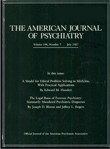Natural History of Male Psychological Health, XIV: Relationship of Mood Disorder Vulnerability to Physical Health
Abstract
OBJECTIVE: A 55-year prospective study attempted to determine the antecedents and consequences of positive mental and physical health in adult men. A substudy was conducted to look at the late-life physical health of men selected to be as unlike men with major depressive disorder as possible. METHOD: Of 237 men selected for health and followed since college, 64 undistressed men had never used mood-altering drugs or consulted a psychiatrist before the age of 50. The health at age 70 of these 64 men was compared with that of 20 men classified as depressed at age 70, 109 men classified as neither healthy nor depressed at age 70, and 44 men classified as having alcohol dependence or abuse at age 70. RESULTS: At age 70, the 64 undistressed men enjoyed significantly better health than the 109 men in the intermediate group. Only three (5%) of the 64 undistressed men were dead or disabled by age 70, compared with 30 (28%) of the 109 men in the intermediate group and nine (45%) of the 20 depressed men. The mean age of the subjects' maternal grandfathers at death also significantly differentiated the three groups. The differences in longevity among the three groups could not be explained by personality disorder, by cigarette, dietary, or alcohol abuse, or by longevity of the subjects' other first-degree ancestors. CONCLUSIONS: These findings lend support to the hypothesis that risk of affective disorder may lie along a continuum. At one extreme may be men with stable lifestyles, a lifelong resistance to mood disorder, and unusually good physical health in late life. At the other extreme of the continuum may be men with vulnerability to mood disorder and accelerated physical aging. (Am J Psychiatry 1998; 155:184–191)



